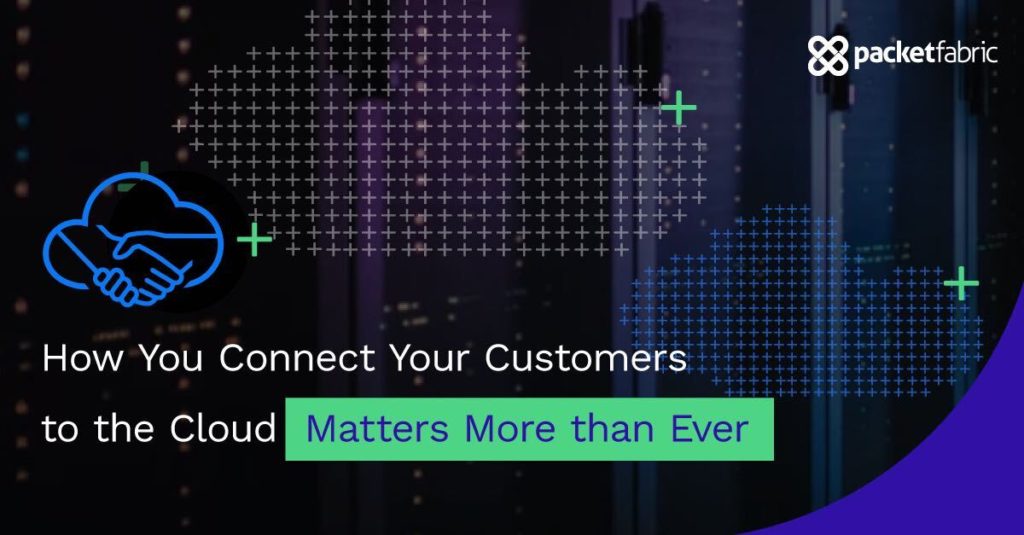Nearly every organization is building its digital business future based on a hybrid and multi-cloud architecture.
Cloud is the IT architecture of choice because it allows enterprises to deliver digital experience to customers and employees faster, and offers technical and business model agility to respond to rapidly evolving market opportunities and conditions. Cloud adoption has only accelerated due to the pandemic, which drove business to pursue digital transformation even more intensively than before.
Channel partners including Managed Service Providers (MSPs), Systems Integrators (SIs), Agents/trusted advisors, and Resellers have been capitalizing on this cloud trend and have become essential to design, procurement, and deployment of cloud-based solutions for many enterprises.
However, there is a critical dimension of this transformation that now represents a market opportunity for channel partners that is too important to miss: next-generation cloud interconnection.
The Formation of the Enterprise “Cloud Core”
As enterprises move workloads to the cloud, they start to form what we call their “cloud core.” The cloud core is the hybrid and multi-cloud set of colocation data centers, cloud service providers (CSPs), and SaaS providers, between which mission-critical traffic flows. By mission-critical, we mean that if those workflows stop, the business stops.
One example is payment processing which depends on multi-cloud communications between issuer processing hosted in AWS and merchant payment processing in Google Cloud. Another example is aggregation links from colocation-based network hubs that dozens of office locations connect through to access business-critical applications hosted in hybrid cloud environments.
Traditional Cloud Connectivity Choices are no Longer Good Enough
The mission-critical nature and volume of these app-to-app, machine-to-machine, and aggregated user workflows means that Internet-based cloud connectivity is simply not good enough. Even with VPN overlays, Internet connectivity is simply not private or secure enough. Furthermore, the Internet is best effort, with no latency SLAs. High latency, and worse, highly variable latency crossing Internet transit causes throughput and performance problems for transactional and other critical systems.
Loss of effective system speed leads to significant business impacts. Finally, the high volumetrics of these workflows is at odds with many cloud provider network consumption models, and can cause non-trivial cost-efficiency issues.
The alternative to Internet connectivity has been traditional telco connections. Sadly, while this option offers predictable performance backed by SLAs, security and privacy, and predictable bandwidth costs, it comes weighed down by a notable lack of agility in three dimensions.
First off, traditional telco connections require a long-term, up-front commitment. In business, there are steady state needs, but there are also seasonal, and project/innovation needs that long-term contractual bandwidth commitments don’t fit. Furthermore, disruptions like pandemics, M&A events, and emerging opportunities can alter the steady state and require a rapid change of IT resource allocation. Cloud resources are well suited to meet all these needs, but long-term telco commitments aren’t.
Second, traditional telco connections require IT and telecom buyers to commit long-term based on peak anticipated capacity, and in too many cases, a major portion of that bandwidth gets wasted.
Third, it can take quite a long time to engage, procure, and provision traditional telco connections. Ultimately, the lack of agility in traditional telco connectivity is a blocker to realizing value from the enterprise cloud architecture.

Enter Next-generation Cloud Interconnection
Fortunately, there is a better way to connect the enterprise cloud core. PacketFabric built a global, private, secure optical network that offers on-demand Layer 2 connectivity between hundreds of colocation data centers, CSPs like AWS, Azure, GCP, IBM, and Oracle, major SaaS providers like Salesforce and Webex, and a broad ecosystem of Internet Exchange, SaaS, Disaster Recovery and Backup as a Service, and other providers.
PacketFabric is purpose built for hybrid and multi-cloud IT, designed to deliver all the agility, scalability, predictable performance, and flexible consumption that enterprises need from their cloud ecosystems. IT and telco buyers can connect ports at low cost to the network in colocation DCs, and create any number of virtual connections to other DCs, hosted cloud on-ramps, and other providers, at different terms from month-to-month and longer. If high performance multi-cloud connectivity is the requirement, it’s even easier, with zero hardware and zero touch to connect.
The PacketFabric network is massively scalable and resilient, built at multi-100G per PoP, with redundant stacks and paths. Just recently, Cisco shared that PacketFabric is an early adopter deploying 400G based on Cisco Silicon One.
It’s ridiculously fast and easy to get services provisioned on-demand via our portal, and to automate bandwidth management via our API.
A Massive, Not-to-be-Missed Market Opportunity
As enterprises embrace cloud, the opportunity to help them achieve their goals by freeing cloud connectivity from the constraints of the past is a huge opportunity for channel partners. Not only is this a multi-billions of dollars market, but channel partners can benefit in multiple ways from positioning next-generation cloud connectivity.
- Increase your value as a trusted cloud advisor by steering customers to cloud connectivity that doesn’t compromise on security, performance, agility, or cost-efficiency
- Expand your share of overall customer cloud spend
- Help customers improve management of their digital experience delivery with private connectivity that offers superior, built-in visibility as compared to Internet-based transport or traditional telco options
- Help customers create a more agile and cost-efficient cloud architecture, achieve more successful digital transformation, and gain stickier relationships
- Go to market fast with easy entry points and capitalize on huge upsell opportunities
Learn More
Analysts have long noted that networking has lagged cloud in automation. That is no longer the case. It’s time to unlock the next phase of cloud value for your customers and your channel business. Learn more about the PacketFabric platform and services. If you know you’re ready to explore becoming a PacketFabric partner, let’s get in touch!